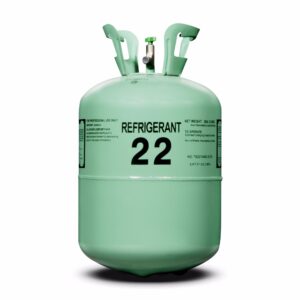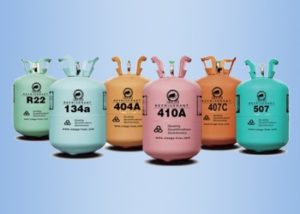In today’s world, refrigerant is getting more expensive, criminals are getting craftier, and others may be trying to find a cheap way to get high. That’s why we want to inform you of the new refrigerant laws you need to know.
We’ll explain the EPA’s R-22 phase-out and other ozone-depleting substances, drop-in refrigerants, aka R-22 replacements, the theft of HCFC refrigerants, and what it all means for consumers like you.
Frequently Asked Questions:
- Is R-22 already phased out?
- I live in or around the Dallas/Fort Worth, TX, area. Can I get a quote?
- What does this mean for me?
- Can you still buy R-22?
- Where can you buy R-22?
- How much does it cost to retrofit an R-22 system to an R-22 replacement refrigerant?
- Is there a replacement for R-22?
- Why is R-22 being phased out?
- What is a drop-in refrigerant?
- Is there a drop-in refrigerant for R-22?
- What is an HCFC refrigerant?
- What are the new refrigerant laws?
- How can I retrofit an R-22 system with an R-22 replacement refrigerant?
- Why haven’t I heard about the new refrigerant laws until now?
- Can I use the new refrigerant (R-410a) in my existing R-22 equipment?
EPA Phased Out HCFC Refrigerants Completely After 2020
Is R-22 already phased out?
Yes, R-22 is already phased out. There are a few ways to get around this, however. If you want to find out how you can still get R-22, or R-22 replacement refrigerants, you’ll want to check this out or keep reading. R-22 was scheduled to be completely phased out by the EPA by Jan. 1, 2020.

What is an HCFC refrigerant?
HCFC stands for hydrochlorofluorocarbon. R-22, also known as HCFC-22 or chlorodifluoromethane, is the most widely used HCFC refrigerant. Chances are, if you have an AC system over 10 years old, you’re using this refrigerant. As of Jan. 1, 2020, these refrigerants were phased out by the EPA.

Why is R22 being phased out?
The EPA has found that HCFCs are depleting Earth’s ozone layer and has been systematically phasing out these refrigerants with these new refrigerant laws for quite some time. However, there are quite a few R-22 replacement refrigerants on the market that can help you get by until you’re ready to replace your air conditioning system. You might want to check into this, as it could be a good option for you.
Why haven’t I heard of the new refrigerant laws?
Most people simply haven’t noticed the rising prices until now. The EPA started a 10-year phase-out plan in 2010. Every year, manufacturers of HCFC refrigerants like DuPont, for instance, have been required to scale back production more and more. It may not have been as noticeable until recent years when the price hike started to skyrocket due to high demand and low supply.
If you’re not in a position to purchase a new HVAC system… there’s another option.
Can you still buy R-22?
Yes. While R-22 refrigerant is no longer in production, an extremely limited supply of recycled R-22 is still on the market. However, prices are extremely high. If you plan on keeping your R-22 system, a better option would be retrofitting your system to an R-22 replacement refrigerant. It may cost a little bit more upfront, but you’ll save a ton of money on refrigerant in the future.
Where can you buy R-22?
Some supply shops still offer an extremely limited supply of recycled R-22 refrigerant to contractors. Though, it’s important to note that only contractors or technicians with a valid 608 certification can purchase R-22 refrigerant.
In most cases, customers are much better off retrofitting their system to an R-22 replacement refrigerant.
What does this mean for me?
With these new refrigerant laws, manufacturers can no longer make R-22 or any other HCFC refrigerants after 2020 due to the R-22 phase-out. So, if it’s already costing you a lot to top off your air conditioner, you can only expect it to get worse. Thankfully, there is another solution you might be interested in.
What’s a drop-in refrigerant?
Drop-in refrigerants replace other refrigerants.
This can be a complex subject, as this term can mean different things to different people. Some think of a “drop-in” refrigerant as a refrigerant that can be mixed with the refrigerant that is already in your equipment, such as R-22.
Others think of “drop-in” refrigerants as refrigerants that are compatible with the original refrigerant designed for your equipment (such as R-22), but do require that the existing refrigerant be recovered and possibly a few extra measures be taken, such as an oil change or changing of the liquid line drier before charging the system with the new “drop-in” refrigerant. We call this a retrofit.
Is there a drop-in refrigerant for R-22?
Yes, there are many drop-in replacements for R-22, but you’ll want to read this before moving forward because they may not be what you think.
However, there are no drop-in refrigerants available that can be mixed with R-22 at this time.
How much does it cost to retrofit an R-22 system to an R-22 replacement refrigerant?
It costs $900 to $1,500 on average, based on what we found among the most reputable companies, to retrofit an existing R-22 system with an R22 replacement refrigerant. It can be expensive to do, but it could help you get around the R-22 phase-out by the EPA for a little longer if you need to.
If you live within our service area, we would be happy to help you retrofit your HVAC system.
Contact us at (817) 985-3613 to schedule service.
How can I retrofit an R-22 system with an R-22 replacement refrigerant?
Your Section 608-certified technician will need to recover all existing R-22, pull a vacuum on your system, and then charge it back up with a new drop-in refrigerant like R422D, MO99, R407C, or whichever R-22 replacement would be applicable to your system.
In some cases, an oil change on your system and the changing of your drier may also be needed to prevent contamination. There is a cost to retrofitting your system to a drop-in refrigerant, but it will save you tons of money in the long run (if you plan on keeping your system that long).
Can you use R-410A in an R-22 system?
No, you cannot use R-410A refrigerant on your R-22 equipment. While in some cases, it may be possible to use parts of your existing HVAC system, it is usually not recommended. However, even if you were to use your existing evaporator coil, air handler, or furnace, you would still need to change out your condenser. This is because R-410A refrigerant runs at higher pressures and has mostly different characteristics than R-22.
Your compressor was not designed to use this refrigerant, and unfortunately, it just won’t work. It makes more sense to replace your system as a whole, but you might be interested in retrofitting your system to a drop-in refrigerant.
These refrigerants are designed to combat the EPA’s R-22 phase-out and can take the place of R-22 without needing to replace your equipment.
What are the new refrigerant laws?
IRC M1411.8 and IMC 1101.10 have been put into effect in many areas around the U.S., which require that all accessible HVAC refrigerant ports be secured with tamper-resistant caps. These laws are not associated with the R-22 phase-out by the EPA but could help if your R-22 or other refrigerants are being stolen. This will help protect your heating and AC system from theft.
Why were the new refrigerant laws made?
Originally, these mandates were brought into effect in an effort to reduce the number of teen AC-refrigerant-related huffing deaths. After 2020, consumers are required to upgrade to R-410A refrigerant and equipment or use drop-in refrigerants. This is because the EPA decided that 2018 would be the last year of the phase-out plan. Since the price hike, there have been countless reports of stolen R-22 across the United States. With an extremely limited supply of recycled R-22 available, those numbers can be expected to increase.
It may be time for you to have tamper-resistant caps installed on your system.
How do tamper-resistant caps work?
Tamper-resistant caps work the same way your old caps do, except these caps can be opened with a key that only your technician has.
How much do tamper-resistant caps cost?
We charge $50 for the caps, but the price can vary depending on your HVAC service provider.
If you’d like to have them installed, contact us or call (817) 985-3613 to schedule service.
(It’s important to note that the information in this news report is not 100% accurate. R-22 is not the only refrigerant being huffed or stolen. Even the newer refrigerants, such as R-410A, are experiencing similar issues. These newer refrigerants are still subject to the same laws.)


